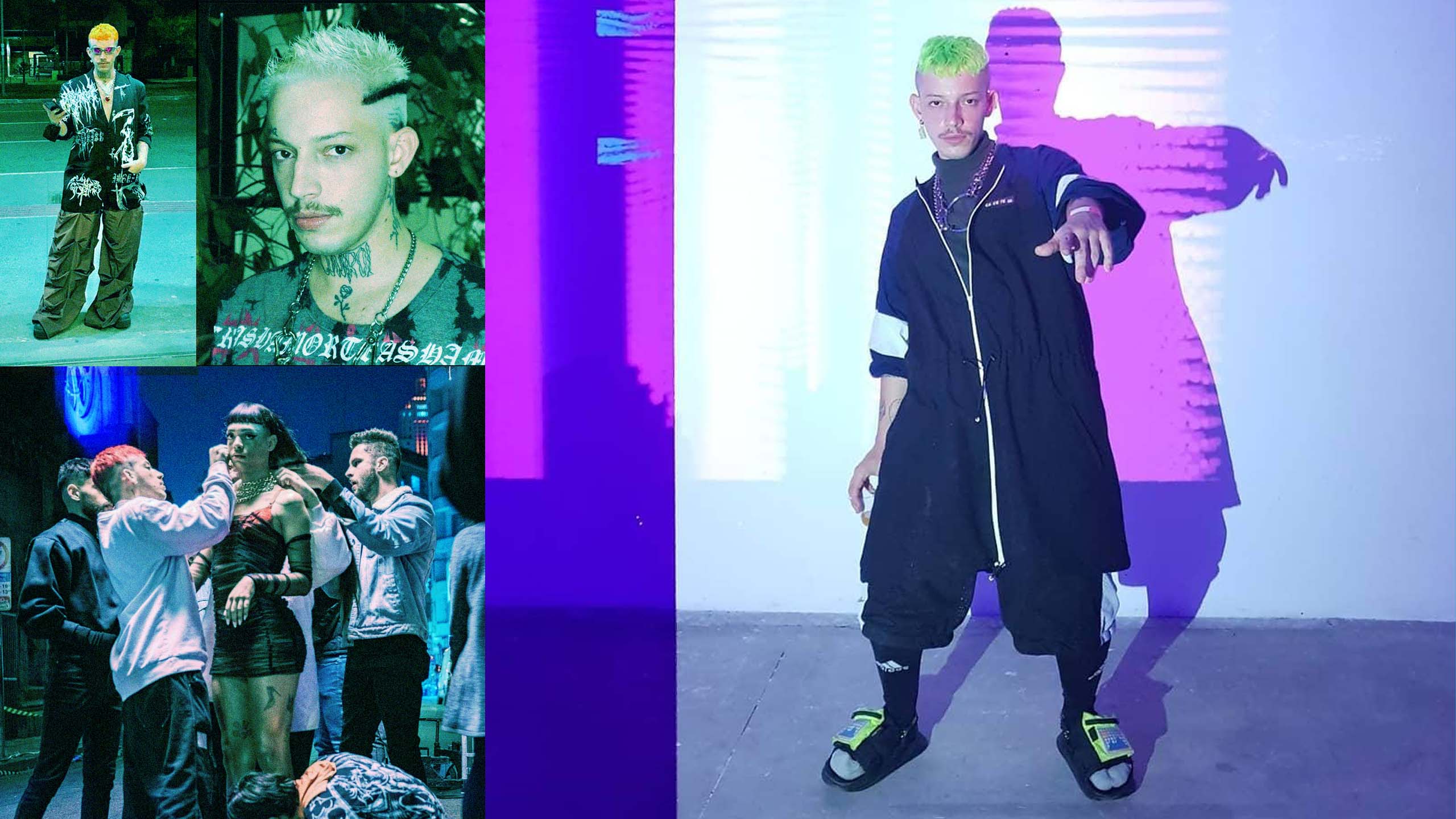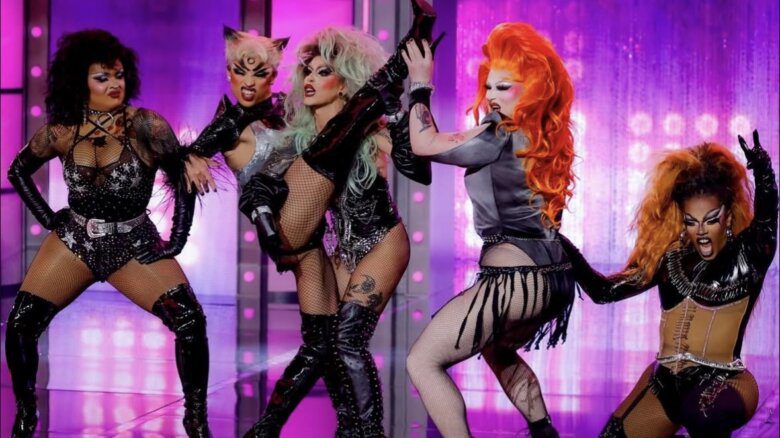When Olavo Dias was younger, he didn’t have a lot of outlets to express his passion for fashion. Growing up poor in the deeply conservative rural city of Uberaba in Brazil’s Minas Gerais, he idolized pop divas like Beyoncé, Björk and Rihanna. When he was 12 years old, Lady Gaga piqued his interest in designers, and he saw himself perhaps becoming a stylist for artists. But these U.S.-based stars could only inspire him so much; the world of celebrity and artistry seemed so far away.
“I imagined that accessing this universe was something really impossible, despite my privilege [as a white person], due to the barriers that arise from being LGBTQ+ in Brazil,” he says. In recent years, Brazil has recorded record numbers of killings of trans people, and its far-right president, Jair Bolsonaro, implicitly endorses the violence queer and trans folks experience, among other anti-LGBTQ+ policies.
Yet, there were and are queer and trans artists taking up space in culture, especially in the music industry, in unprecedented ways. And Dias was and is right at the centre of this cultural explosion, having frequented the same clubs as, and eventually becoming friends with, trailblazers like Pabllo Vittar, who is now one of the world’s most famous drag queens. “Witnessing this boom from up close had a very strong impact [on me],” he continues. “Seeing more LGBTQ people working and being recognized on a global level, it’s really gratifying.”
But Dias didn’t just watch this boom happen; he has been helping bring it to life as the stylist for some of Brazil’s most iconic artists, including Luìsa Sonza, Urias, Duda Beat and his friend, Vittar. Xtra recently caught up with Dias to discuss his early career as a stylist, some of his most iconic looks to date and how fashion can be a tool in defeating the regressive rhetoric threatening Brazilian cultures.
You’re successful now, but tell us more about your journey to this point. What were some of the challenges you faced as you grew as a stylist?
I come from a very conservative, evangelical family, and was brought up in this religious context where I couldn’t express myself how I wanted. That has an impact on you growing up. Plus, I’m from Uberaba, the countryside of Minas Gerais, with about 300,000 people. It’s a rural, agricultural and conservative city, where the government has historically been on the far-right, and culture really was not valued. Being an artistic child was hard due to these political and familial matters.
I was lucky that I made many friendships that really changed my life. I started off working in sales, then I moved to Uberlândia, a slightly bigger city, where I met Pabllo Vittar and Urias, who, at the time, were doing drag in clubs, but were not famous. I was a DJ, so we met in this nightlife context. My sales job paid my bills, but at night we breathed this art. I saw my drag queen friends, helped them with their clothes and got to express myself through style. Through these connections, things started changing.
Pabllo started having access to her fame and visibility, which impacted everyone around her. Then I started thinking, “Shit, this is possible.” To be very honest, I didn’t even know the profession of stylist existed until Pabllo needed styling for the video for “Nêga.” That’s when I started getting interested and pursuing this career.
Your work is often a love letter to Brazilian culture and designers. Can you tell me more about your focus on new and LGBTQ+ brands?
Fashion is very important for our expression. And we talked about barriers, but our community can go beyond those. I’ve always prioritized working with independent brands because they’re really making fashion. When you come from the margins, with no backing, and make something so beautiful like people are making here, it’s wonderful to see.
When I work on a video, we want to work with people we believe in because of their message, regardless of their follower count. Some of my friends work on a brand called Unusual, with an upcycling concept that transforms clothes into something amazing. There’s Trashboy, who paints! Sometimes he can take a top that’s just a simple top, and make it into beautiful art.
What would you say are some of your most noteworthy looks to date?
The red, final look of “Diaba,” by Urias. This final look was talked about a lot, and we spent a lot of time and resources on it, even though it was only shown for five seconds. We wanted a look that was very impactful, that was going to be shown only at the end scene. This is the most important look of my career so far. “Toma,” by Mateus Carrilho, I am very thankful for. The opportunity he gave me to be a stylist for the first time on a video was incredible.
But I would say that “Diaba” was, and continues to be, a divider in my life. There is no way to describe the impact, because not only do Urias and I have a long friendship, but it was also her first clip, and done with a very small budget. So we did “Diaba,” which exploded, and we said, “Shit, let’s work a lot. Now we’re gonna be able to make some money together with our art.” Then we released “Racha,” and the pandemic hit.
Lexa, Cleo and Duda Beat were other big names in Brazil that I worked with and am very grateful for. Other smaller artists were equally important, like Ana K, who helped me break from my usual underground, street-style references.
It’s very important to focus on the relationships of support between creator friends, because we can open doors for one another. And I’m very thankful that my biggest opportunity came from a Black, Brazilian trans woman, Urias. We need to get into the system to be able to break it. Accessing the system is not easy, so we must gather strengths with our people, so we can defeat it.
You’ve continued working throughout the pandemic, and the “dis-government” of Bolsonaro. What kept you going?
Honestly, it was very complicated for the whole scene because the fashion and audiovisual world in Brazil is still very precarious; it’s not valued. Our Fashion Week, the main industry window of the country, is extremely elitist, and, on top of that, we’re not backed by the government, not even in a minimal way.
We had to reinvent ourselves, trying looks on through video calls. I was lucky to work with Urias, and we were able to execute productions with little money. But it was very difficult and a lot of hard work. We were, and continue to be [poorly governed]. The audiovisual [industry of music and fashion] completely stopped, and those most at the margins were hit the hardest. It was hard finding means to create within this pandemic.
What do you see as the role of fashion in bringing about social change in Brazil and beyond?
Fashion is one of the most genuine ways for people to express themselves. This became a huge industry, generating billions of dollars worldwide, but there are countless people at the margins and minorities who produce incredible things. Being part of these communities, it is important for us to build our net of support and create our own movement.
It was in this local web of support that I found myself. Our circle creates unbelievable things, and we need to bring attention to those people. It’s beautiful to unite, tell our stories and break the system from inside out through our togetherness and the talents we have in our own relationships. May we create our own spaces with people that we believe in, so we can unify our powers, as a community, to create platforms of expression. It is possible, and it is happening.
This interview was conducted in Portuguese. It’s been translated and edited for clarity.


 Why you can trust Xtra
Why you can trust Xtra


